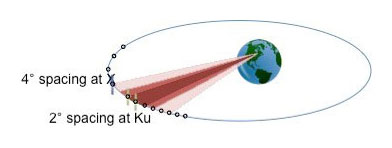All About Space

If I asked you today what optimal spacing is, you would probably say, ‘at least 6 feet’. But when this blog was originally conceived, we were not yet social distancing. And the spacing we had in mind was about satellites, not about social situations. We understand how proper spacing helps slow the spread of a virus, but before 2020, did we understand that more space between things was a good thing and an advantage? We strive to live closer to work, close to the Metro or our favorite restaurant. We seek homes that are close to the schools and the shops. Can you think of an instance where a greater distance between two objects is seen as an advantage? (insert in-law joke here).
But there are indeed advantages to greater spacing between satellites and that all comes down to two main areas: reduced interference and efficiencies.
Adjacent satellite interference can be costly and serious. It most often occurs in those frequency bands with satellites which are placed closer together, typically 2 degrees apart. X-band satellites, however, have twice the amount of spacing and therefore a much lower chance of adjacent satellite interference. Vital when a message needs to go through.
This wider spacing has another significant benefit; allowing the efficient transmission of high data rates with small (sub-meter) antennas. X-band satellites can operate at higher uplink and downlink EIRP/power densities than commercial satellites with smaller degrees of spacing. By having the higher allowable EIRP/Power densities, small antennas can transmit without using spread spectrum techniques. Employing these techniques causes an increase in bandwidth requirements to ensure transmission, and of course more bandwidth equals higher cost. This is important to consider, especially when bandwidth-heavy applications such as HD video and imagery are required for today’s missions.
Sometimes more space is a good thing.